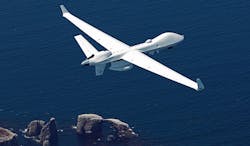Navy asks Raytheon for electro-optical multispectral sensors for MQ-9, MQ-8, and other unmanned aircraft
CRANE, Ind. – U.S. Navy electro-optical surveillance experts needed next-generation multispectral targeting sensors for the MQ-9 Marine Air-Ground Task Force (MAGTF) attack drone and other unmannedunmanned reconnaissance aircraft. They found their solution from Raytheon Technologies Corp. (RTX)
Officials of the Naval Surface Warfare Center Crane Division in Crane, Ind.,, announced an $47.9 million order Friday to the RTX Raytheon segment in McKinney, Texas, to provide nine AN/DAS-4 multi-spectral targeting systems (MTS) and spare parts.
The AN/DAS-4 system of multispectral sensors offers four high-definition cameras covering five spectral bands; a three-color diode pump laser designator and rangefinder; laser spot search and track capability; automated sensor and laser bore sight alignment; three mode target tracker; and built in provisions for future growth, Raytheon officials say.
The order is on behalf of the U.S. Naval Air System Command’s Program Office for Multi-Mission Tactical Unmanned Aerial Systems, which is responsible for MQ-9 MAGTF unmanned aerial vehicle (UAV), the MAGTF Expeditionary (MUX) family of systems (ACAT II) program, and the MQ-8 Fire Scout unmanned helicopter.
Related: Sensor payloads for unmanned vehicles
MUX is to be a medium-to-large-size UAV that launches from surface ships and can land either on a flight deck or in an unimproved airfield to supplement smaller fixed-wing UAVs and unmanned helicopters.
The AN/DAS-4, the latest variant of the Raytheon MTS sensor family, incorporates greater fire control and target location accuracy technology than previous MTS versions for precise coordinates.
The AN/DAS-4 MTS enables mission commanders to use high-definition data from an airborne tactical sensor to identify and engage targets with much greater accuracy than previous-generation systems, Raytheon officials say. This sensor system also is going aboard the U.S. Navy MQ-4C Triton long-range maritime patrol UAV.
This advanced electro-optical and infrared (EO/IR) system provides tracking and laser designation for the Griffin and Paveway missiles, as well as all tri-service and NATO laser-guided munitions. MTS sensors offer several fields of view, electronic zoom, and multimode video tracking.
Multispectral sensors divide images and video into several light wavelengths -- typically three to 15 spectral bands -- across the electromagnetic spectrum, including light from frequencies beyond the visible light range such as infrared and ultra-violet.
Dividing images into several different wavelengths enables the sensor to extract additional information the human eye fails to capture with its receptors for red, green, and blue.
On this order Raytheon will do the work in McKinney, Texas, and should be finished by March 2027. For more information contact RTX Raytheon online at https://www.rtx.com/raytheon.
